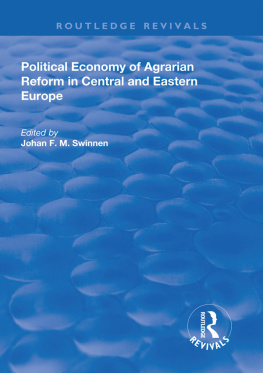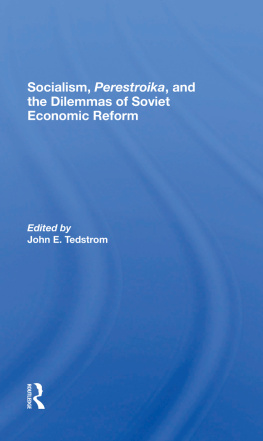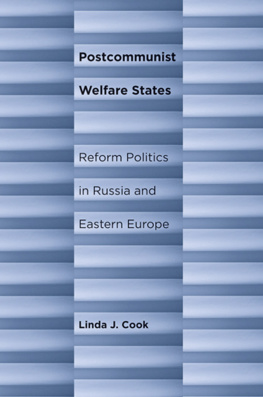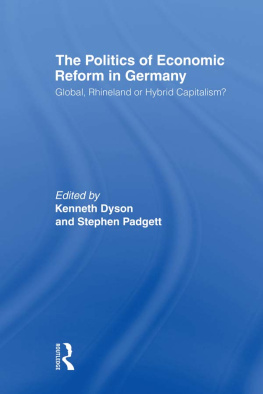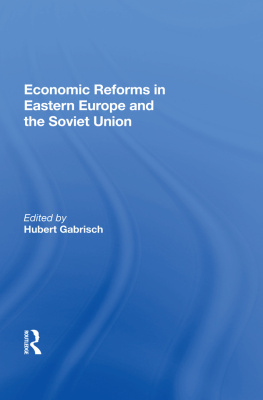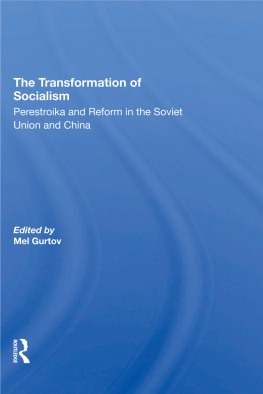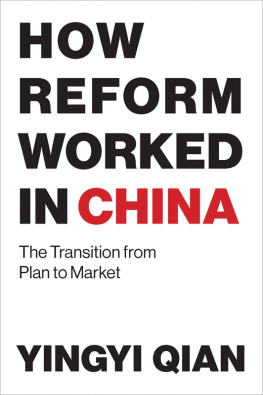First published 1990 by Westview Press, Inc.
Published 2019 by Routledge
52 Vanderbilt Avenue, New York, NY 10017
2 Park Square, Milton Park, Abingdon, Oxon OX14 4RN
Routledge is an imprint of the Taylor & Francis Group, an informa business
Copyright 1990 Taylor & Francis
All rights reserved. No part of this book may be reprinted or reproduced or utilised in any form or by any electronic, mechanical, or other means, now known or hereafter invented, including photocopying and recording, or in any information storage or retrieval system, without permission in writing from the publishers.
Notice:
Product or corporate names may be trademarks or registered trademarks, and are used only for identification and explanation without intent to infringe.
Library of Congress Cataloging-in-Publication Data
Rvsz, G. (Gbor)
Perestroika in Eastern Europe: Hungarys economic transformation,
19451988 / Gbor Rvsz; with a foreword by Paul Marer.
p. cm. (Westview special studies on the Soviet Union and
Eastern Europe)
Includes bibliographical references.
ISBN 0-8133-7752-8
1. HungaryEconomic policy1945 . 2. Central planningHungary.
3. Perestroika. I. Title. II. Series.
HC300.28.R48 1900
338.9439'009'045dc20 89-37019
CIP
ISBN 13: 978-0-367-28261-5 (hbk)
Among the countries that have had a centrally planned economic and communist political system and have remained in the Soviet sphere of influence, Hungary has beenand remainsa pioneer in pursuing economic and political reforms. Hungary's reform experiment, now more than twenty years old, has been both fascinating and historically important.
The historical importance of Hungary's experiment is, in my view, threefold. One reason is the lesson that it teaches us about one of the great and as yet not fully settled questions in comparative systems: Is efficient market socialism a realistic possibility? (I define "efficient market socialism" as [1] a well-performing and substantially market-driven economy in which [2] the means of production remain predominantly nonprivate, [3] the government assumes responsibility for an economic policy that substantially circumscribes economic activities, [4] the distribution of income and wealth is relatively egalitarian, and [5] the political party that governs is firmly committed to these four economic principles.) The experience of Hungary suggests that the answer may well be negative, certainly until the ownership issue is resolved in a way that is consistent with market efficiency.
The further historical importance of the Hungarian experiment lies in the fact that it suggests that the dynamics of the reform processes in centrally planned economies have certain common and predictable intellectual, political, and bureaucratic features. Although no two countries are alike in their environments and policies, there is much that reformers of centrally planned economiesand outside observers of the reform processcan learn from Hungary's experience as they try to shape, and we in the West attempt to understand and predict, future developments in the Soviet Union, Poland, and elsewhere. As the author himself states at the beginning of :
It is worth noting that the very successful changes adopted in China in the 1980s were in many ways based on the Hungarian experience; likewise, Gorbachev's perestroika and the subsequent economic renewal in several Eastern European countries have numerous points in common with events that began in Hungary some twenty years ago. The mistakes and the fact that Hungary's reform was halted at one stage may also prove instructive.
An even more important lesson of the Hungarian experiment is that as long as real market pressuresand opportunities to excel by offering superior productsremain limited by pervasive government intervention in the economy, progress will be halting, so that even a "reformed" country like Hungary will fall further and further behind the newly industrializing and already industrialized market-economy countries. Whether Hungary can break out of its present predicament by "escaping forward" is a question that is crucialbut very difficult to answer.
Perhaps the greatest historical significance of Hungary's reform experiment is the substantial direct impact that the outcome of its reform-cum-transformation will have on political and economic developments in the USSR and elsewhere in Eastern Europe. If the Hungarian experiment is associated with sustained political instability and deteriorating economic performancea distinct possibilitythat fact will certainly weaken the reform program of Gorbachev and those of his like-minded colleagues in the USSR and in the other Eastern European countries. Conversely, ifafter a period of transitionthe Hungarian experiment leads to political stability under a more democratic political system as well as to sustained improvements in economic performance, that fact will surely boost the positions of the reformers elsewhere.
Western assessments of Hungary's reform experiment have been somewhat superficial and faddish. From the late 1960s until the mid-1980s, the Hungarian experiment was evaluated in the West much too favorably. In recent years, when many hitherto hidden problems have surfaced, Western comments have tended toward the opposite extreme, pronouncing the Hungarian experiment a failure.
We are fortunate to have in hand this objective account and balanced assessment of Hungary's reform experiment. This book is a valuable addition to the meager literature available in the English language on Hungary's reform process and results. It is an account by an "insider" who has superb knowledge of the facts and an ability to take a detached, independent, academic view of the unfolding reform process.
The author, Gbor Rvsz, is one of Hungary's distinguished economists. During his forty-year career, he has worn a variety of hats. For about two decades (1949-1967), he held a series of positions in Hungary's state economic administration: in the Ministry of Finance, at the Investment Bank, and in the National Planning Office. He served also as a member of the committee of experts that prepared the New Economic Mechanism introduced in 1968. Early on in his career, Dr. Rvsz began teaching economics at various colleges and universities in Hungary (an activity he still continues), and he has made guest appearances abroad, in the East, and also in the West. Since 1967, his principal position has been that of a senior research economist at the Institute of Economics of the Hungarian Academy of Sciences, where his research has focused on broad questions of reform strategy, especially on labor and compensation issues. Dr. Rvsz is the author of numerous publications; some of them have appeared in English.
This book was completed in November 1988, just about the time when Hungary was entering a new and accelerated phase in its economic and political reform process. Although sketches some of the fascinating new developments that took place during 1987 and 1988, giving the reader a sense of the dramatic events that were unfolding in Hungary at that time, the author is obviously not in a position to make an assessment that is fully up-to-date and definitive. Attempting such an assessment will be the task of economic historians for years.


